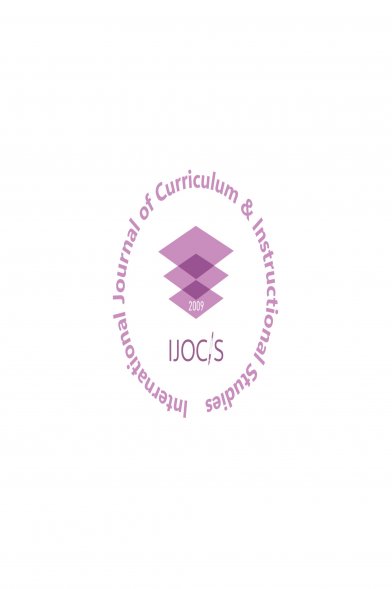Oyunlaştırma Temelli "Öğretim İlke ve Yöntemleri" Dersi Öğretim Programı Hakkında Öğrenci Görüşleri*
Students' Views about Gamification Based Curriculum for the Lesson of "Teaching Principles and Methods"
___
- Barata, G., Gama, S., Jorge, J. & Gonçalves, D. (2013). Engaging engineering students with gamification. 5th International Conference on games and virtual worlds for serious applications (VSGAMES).pp. 1-8. IEEE.
- Bayraktar, Ö. (2015). Bir iletişim modeli olarak oyunlaştırma. İstanbul: Selis Kitaplar.
- Bell, K. R. (2014). Online 3.0---the rise of the gamer educator the potential role of gamification in online education (Order No. 3635727). Available from ProQuest Dissertations & Theses Global. (1615085697). Retrieved from http://search.proquest.com/docview/1615085697?accountid=15958
- Bozkurt, A. (2014). Bilgisayar oyun pazarı ve Türkiye. Anadolu Gazetesi.
- [http://www.anadolugazete.com/aslihan-bozkurt/bilgisayar-oyun-pazari-ve-turkiye-164.html]. Erişim tarihi: 01/07/2015.
- Buckley, P. & Doyle, E. (2014): Gamification and student motivation, Interactive Learning Environments, DOI: 10.1080/10494820.2014.964263.
- Bunchball, Inc. (2010). Gamification 101: An introduction to the use of game dynamics to influence behavior.
- Demirel Ö. (2008). Kuramdan uygulamaya eğitimde program geliştirme. (11. Baskı). Ankara: Pegem Akademi, s.105.
- Deterding, S., Dixon, D., Khaled, R. & Nacke. L. (2011). From game design elements to gamefulness: defining "gamification". In Proceedings of the 15th International Academic MindTrek Conference: Envisioning Future Media Environments (MindTrek '11). ACM, New York, NY, USA, 9-15.DOI=10.1145/2181037.2181040.
- Domínguez, A., Saenz-de-Navarrete, J., De-Marcos, L., Fernández-Sanz, L., Pagés, C. & MartínezHerráiz, J. J. (2013). Gamifying learning experiences: Practical implications and outcomes. Computers & Education, 63, 380-392.
- Eleftheria, C. A., Charikleia, P., Iason, C. G., Athanasios, T. & Dimitrios, T. (2013). An innovative augmented reality educational platform using Gamification to enhance lifelong learning and cultural education. In Information, Intelligence, Systems and Applications (IISA), 2013 Fourth International Conference on (pp. 1-5). IEEE.
- Faghihi, U., Brautigam, A., Jorgenson, K., Martin, D., Brown, A., Measures, E., & MaldonadoBouchard, S. (2014). How Gamification Applies for Educational Purpose Specially with College Algebra. BICA2014, Procedia Computer Science. 41, 182-187.
- Grace, M.V. & Hall, J. (2008). Projecting Surveillance Entertainment. Presentation, ETech, San Diego: CA.
- Hamari, J., Koivisto, J., & Sarsa, H. (2014). Does gamification work? A literature review of empirical studies on gamification. In System Sciences (HICSS), 2014 47th Hawaii International Conference on System Science (pp. 3025-3034). IEEE.
- Harrold, D. J. (2015). Game on: A qualitative case study on the effects of gamified curriculum design onstudent motivational learning habits (Order No. 3691842). Available from ProQuest Dissertations &Theses Global. (1673159776). Retrieved from http://search.proquest.com/docview/ 1673159776?accountid=15958
- Lee, J. J. & Hammer, J. (2011). Gamification in education: What, how, why bother? Academic Exchange.Quarterly, 15(2), 1-5.
- McDonald, M., Musson, R., & Smith, R. (2008). Using Productivity Games to Prevent Defects. In M. McDonald, R. Musson, and R. Smith, eds., The Practical Guide to Defect Prevention, Microsoft Press,Redmond, 2008, 79-95.
- Measles, S. & Abu-Dawood, S. (2015). Gamification: Game-Based Methods and Strategies to Increase Engagement and Motivation within an eLearning Environment. In Society for Information Technology & Teacher Education International Conference, 2015 (1), 8319-8324.
- Natronbaxter.com (tarih yok). Gamification. [http://natronbaxter.com/]. Erişim tarihi: 25.02.2015. Robertson, M. (tarih yok). Can't Play, won't Play. [http://kotaku.com/5686393/cant-play-wont-play]. Erişim tarihi: 04.11.2015.
- Rouse, K. E. (2013). Gamification in science education: The relationship of educational games to motivation and achievement (Order No. 3569748). Available from ProQuest Dissertations & Theses Global. (1370800410). Retrieved from http://search.proquest.com/docview/1370800410?accountid=15958
- Sheldon, L. (2011). The multiplayer classroom: Designing coursework as a game. Boston:Cengage Learning.
- Simões, J., Redondo, R. D. & Vilas, A. F. (2013). A social gamification framework for a K-6 learning platform. Computers in Human Behavior, 29(2), 345-353.
- Strauss, A. & Corbin, J. (1998). Basics of qualitative research: Procedures and techniques for developing Grounded Theory (2nd Edition). London: Sage Publications.
- Toda, A. M., Do Carmo, R. S., Silva, A. L. & Brancher, J. D. (2014). Project SIGMA-An Online tool to aid students in Math lessons with gamification concepts. .[ http://www.jcc2014.ucm.cl/ jornadas/EVENTOS/SCCC%202014/SCCC-9.pdf]. Erişim tarihi: 09/12/2015.
- Uşun, S. (2012). Eğitimde program değerlendirme süreçler, yaklaşımlar ve modeller. Ankara: Anı Yayıncılık.
- Webrazzi.com. (tarih yok). Newzoo: Oyunlara 2015 yılında 91,5 milyar dolar harcanacak. [http://webrazzi.com/2015/04/23/newzoo-oyun-ekonomisi/]. Erişim tarihi: 01/07/2015.
- Werbach, K. (2014). Gamification course.[https://www.coursera.org/course/gamificationn]. Erişim tarihi:25.02.2015.
- Wongso, O., Rosmansyah, Y. & Bandung, Y. (2014). Gamification Framework Model, Based on Social Engagement in E-Learning 2.0. 2nd International Conference on Technology, Informatics, Management,Engineering & Environment. Bandung, Indonesia, August 19-21, 2014.
- Wood, L. C. & Reiners T. (2012) Gamification in logistics and supply chain education: Extending active learning. IADIS Internet Technologies and Society, Perth (Australia), November 28-30, 2012, pp. 101-108.
- Xu, Y. (2011). Literature review on web application gamication and analytics. CSDL Technical Report 11-05.
- Yıldırım, A. & Şimşek, H. (2008). Sosyal bilimlerde nitel araştırma yöntemleri (7. Baskı). Ankara: Seçkin.
- Yüksel, İ. & Sağlam, M. (2014). Eğitimde program değerlendirme (2. Baskı). Ankara: Pegem Akademi.
- Zicherman, G. & Cunningham, C. (2011). Gamification by design: Implementing game mechanics in web and mobile apps (1st ed.). Sebastopol, California: O'Reilly Media.
- ISSN: 2146-3638
- Yayın Aralığı: 2
- Başlangıç: 2011
- Yayıncı: Eğitim Programları ve Öğretim Derneği
Oyunlaştırma Temelli "Öğretim İlke ve Yöntemleri" Dersi Öğretim Programı Hakkında Öğrenci Görüşleri*
İBRAHİM YILDIRIM, Servet DEMİR
Dokuzuncu Sınıf Matematik Dersi Öğretim Programına Bağlılığın İncelenmesi*
Ahmet DİKBAYIR, Nilay T. BÜMEN
Hafif Düzeyde Zihinsel Engele Sahip Öğrenciler İçin Entegrasyon Birimi Modeli: Pupa Projesi*
An Examination of the Researches Related to Teaching Styles Measurement Instruments
Meral GÜVEN, Mustafa POLAT, Günay YILDIZER, Tuğba SÖNMEZ, Nihan YETİM
Meslek Lisesi Sınıflarında Öğretmen Davranışları: Örtük Program Açısından Bir İnceleme*
Güneş KORKMAZ, Semra BAŞARAN DEMİR
The Analysis Of Cartoon Series: Pepee in terms of Cultural Values
